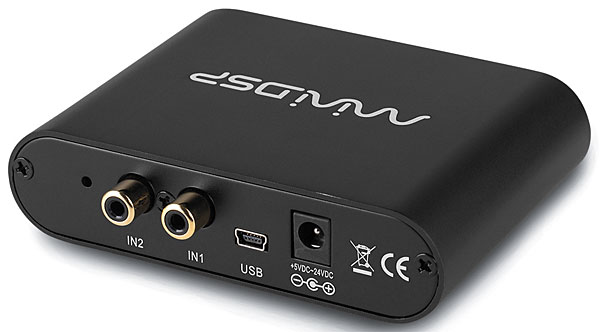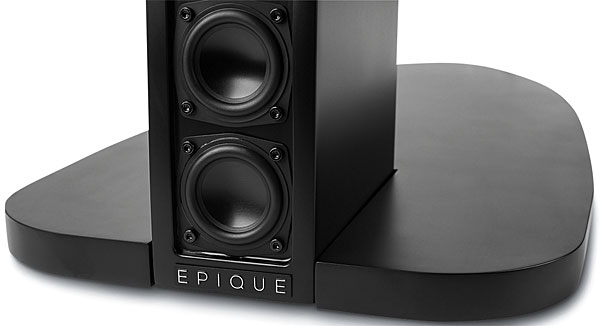Dayton Audio Epique CBT24 Speaker System Review Page 2
Or were they? I set up a carefully level -matched A/B with my everyday Energy Veritas 2.3 stand-mount monitors running full-range, and the long- discontinued Canadians clearly showed a fuller, heavier sound to both the lower half-octave or so of Knopfler’s voice and to the strongly recorded but delicately played Fender bass that underpins the track. And yet— and this is difficult to convey in words—the actual tone color of both the voice and the bass were identical, and in every other regard the timbral match was exceedingly close, though the CBTs’ deeper/broader/rounder image was always in evidence.
I cross-checked this finding with numerous other recordings, as well as with a favorite quick-ref option—TV announcers—and the results were consistent. Despite their near-perfect timbral match, the CBT24s always sounded, well, not lighter exactly, in the bass, but less forward, less weighty, almost less thuddy than the Energys, even though the Veritas are very far indeed from being bass-heavy or boomy.
The conclusion I reached was obvious: floor-bounce. Even though my Energys are a thoroughly engi- neered design of superb accuracy, both by ear and by measurement, and were mounted on stands at the recommended height and placed at a distance carefully derived from years of listening, they are no doubt still subject to floor-bounce. As noted, this produces a hump/dip somewhere around 150 to 200 Hz. The CBT24s, according to both my ears and Dayton Audio’s published curves, did not: Their response (as shown on Dayton’s website) looks, and then sounded, smooth and continuous, with nary a serious squiggle in its 6 dB/octave roll-off below about 200 Hz. In consequence, midbass-rich music—like most pop and much jazz—sounded not precisely more lifelike, but somehow less recorded.
And now I’ll move on to imaging. Put plainly, the Epique imaged like no direct-radiating system I’d ever heard, producing the kind of depth, breadth, and float-in-the-ether sound bubble I associate more with panel speakers—electrostatics in particular, and most particularly one of my all-time favorite loudspeakers, the Quad ESL-63 phase-aligned concentric ’stats. For just one example, an oldie-but-goodie Reference Recordings CD of the too-little-heard Weber Clarinet Quintet painted a seriously lifelike aural portrait: The violins, viola, and cello were each clearly delineated by left-right location and stage depth, but were deliciously united in their grouped-string timbre and woody resonance, while the clarinetist (the brilliant, two-way jazz/classical threat Eddie Daniels), grounded firmly just right of center, soared over and through. This was goose-bumping stuff, and the timbral solidity and continuity of the clarinet in particular, over its full range, was impressive.

Some New EQ
I next wished to know whether an outboard equalizer like the miniDSP was an absolute requirement, or, per Dayton Audio’s recommendation, how the auto-correction found in most modern A/V receivers and preamps could suffice. I set up a Marantz SR7007, a flagship model of a couple years back, to avail myself of its top-level Audyssey MultEQ XT, which, at least in my studio, I’ve found to be one of the most effective such systems. I let the Marantz run its auto setup/room/speaker-EQ correction procedure, exploiting the maximum of eight mic positions, for the 2.1-channel system, i.e., the CBTs with my SVS sub. (I then rebalanced the sub’s level by ear, as I inevitably do with every auto-EQ system.)
I cannot say that the result was indistinguishable from what I heard using Dayton’s recommended equalization preset to the supplied miniDSP. For one thing, making any such A/B comparison was not really practicable. But my sense was that it was very, very close: I heard the same lifelike bass alacrity (without any bass deficit). If anything, the image’s breadth, depth, and detail were better with the Audyssey, likely due to its having measured and corrected, to some degree at least, real-world conditions in my room. Whatever the case, the CBTs sounded terrific with the Audyssey/Marantz correction. I found a new ease in listening into the stereo image on an ultra-familiar track like Norah Jones’ “Come Away With Me.” And the deliciousness of its string bass with no attendant floor-bounce thickening—something most of us are so inured to, we don’t even know we’re hearing it—is difficult to overstate. This track’s opening moments feature brushed ride-cymbal, and I did wonder if the CBT24s might not be highlighting, however slightly, an element of “spit” in its timbre, possibly due to a modest response peak, perhaps around 6 to 8 kilohertz. Nevertheless, the air, presence, and detail of the backing track, and the spooky realism of Jones’s holographic voice, were exceptional by any measure.
Despite their svelte profile, the CBTs seemed perfectly happy playing quite loudly—not too surprising for a design with 48 drivers, each rated for 15/30 RMS peak watts power handling. An excellent full-orchestra recording like a Reference Recordings set of the Rachmaninoff Symphonic Etudes/Tableaux could clearly deliver its full dynamic shadings, with strong, air-blast brass attacks and powerful crescendi from material like the “March,” even at verifiable front-of-house levels. And concert-level rock was equally well presented: I could dial up the Allmans’ “Fillmore” live set at very nearly you-are-there volume on a hard-punching track like “You Don’t Love Me” (R.I.P., Gregg!), with no complaints from the speak- ers, or from my ears.
 Some additional random thoughts: The CBT pair’s phantom center image, such as on announcers’ voices, was as solid and stable as any I’ve heard. I could stand 7 feet from the right-hand speaker, directly on axis, and still hear a strong origin point for the voice well to the left, though not quite strictly centered. Nevertheless, that’s impressive. Another benefit claimed for the CBT design is near-uniform vertical dispersion of sound. I checked this, casually, via the classic squat-sit-stand test while playing a pink-noise signal. Here, nearly all conventional multi-way speakers’ sound will vary in a “shoo, shee, shaw” fashion as your ears move into and then out of the in-phase lobe(s) of ideally combined non-coincident-tweeter-and-midrange output. (This is something that concerned designers go to some pains to engineer, causing it to be directed to seated-ear height when their speakers are installed and located properly.) From my everyday Energys, the treble formant changed in just this way as my head moved up and down. But via the CBT24s, the mid-treble timbre remained completely unchanged: It became louder as I went from standing to sitting to floor-sitting height—remember, the level-shading of the CBT24’s half-array design puts the highest-output drivers at the bottom—but otherwise there was simply no change. I had to put my ear closer than 1 foot away to hear any trace of driver-to-driver lobing, and even that was small.
Some additional random thoughts: The CBT pair’s phantom center image, such as on announcers’ voices, was as solid and stable as any I’ve heard. I could stand 7 feet from the right-hand speaker, directly on axis, and still hear a strong origin point for the voice well to the left, though not quite strictly centered. Nevertheless, that’s impressive. Another benefit claimed for the CBT design is near-uniform vertical dispersion of sound. I checked this, casually, via the classic squat-sit-stand test while playing a pink-noise signal. Here, nearly all conventional multi-way speakers’ sound will vary in a “shoo, shee, shaw” fashion as your ears move into and then out of the in-phase lobe(s) of ideally combined non-coincident-tweeter-and-midrange output. (This is something that concerned designers go to some pains to engineer, causing it to be directed to seated-ear height when their speakers are installed and located properly.) From my everyday Energys, the treble formant changed in just this way as my head moved up and down. But via the CBT24s, the mid-treble timbre remained completely unchanged: It became louder as I went from standing to sitting to floor-sitting height—remember, the level-shading of the CBT24’s half-array design puts the highest-output drivers at the bottom—but otherwise there was simply no change. I had to put my ear closer than 1 foot away to hear any trace of driver-to-driver lobing, and even that was small.
According to designer Keele, another interesting effect of a CBT design is that its output does not follow the mean-square law that applies to a theoretical point-source, which most conventional speakers are, more or less. That is, the speakers’ loudness (in free space) does not fall off the expected 6 dB for each doubling of listening distance, but rather by about half that amount. I confirmed this effect semi-scientifically by listening comparisons with my everyday three-way speakers, carefully level-matched at 7 feet, from a bit over twice that distance; from that point, the CBT24s sounded slightly but obviously louder. (Keep in mind that this effect, heard in a room’s reflective space, should be less marked than would be the case in free space.)
I noticed that the CBT24s were in the low range of sensitivity for typical dynamic speakers (again, see our Test Bench for measured details). The design is rated to have a nominal 4-ohm impedance; neither my 150-watt-per-channel power amp nor the Marantz receiver displayed the slightest difficulty in driving them to high levels, and I briefly tried a rated 30-watt-per-channel integrated amp and achieved excellent volume and quality of sound.

And lastly, to return to the CBTs’ stereo image for a moment: Given true stereo production, the image was invariably deep, as well as broad, reaching fully from speaker to speaker (but always remaining in between them), and as you would expect, quite tall. But in the vertical dimension, it was slightly diffuse, lacking a bit of the tight, “flashlight” origin-point—some might call it image specificity—for a centered soloist that the best monitors can conjure. And on the best big-image stereo recordings—like the aforementioned Rachmaninoff— I kept imagining that the depth dimension had a slightly sloped feel, as if the orchestra’s seating stage sloped slightly upward from the proscenium to the backstage direction. This never intruded, though, and I can’t promise that the visual element of the starkly curved CBTs wasn’t influencing my auditory conclusion.
And Then There Was One
I hate to call any product “utterly unique”; for one thing, unique is that part of speech known as a superlative and thus not susceptible to qualification. (It drives me sputtering-crazy when TV reporters and other so-called professionals refer to this or that as “even more unique”; if it’s unique, there’s only one. Period.) But I dare say that Dayton Audio’s Epique CBT24 is even uniquer than that. Keele’s design, obviously, will not be for everyone. (I mean, just look at them….) Nonetheless, any audio-head who is deeply interested in the evolution of the loud-speaker and in sound reproduction in general will want to hear a set.





























































